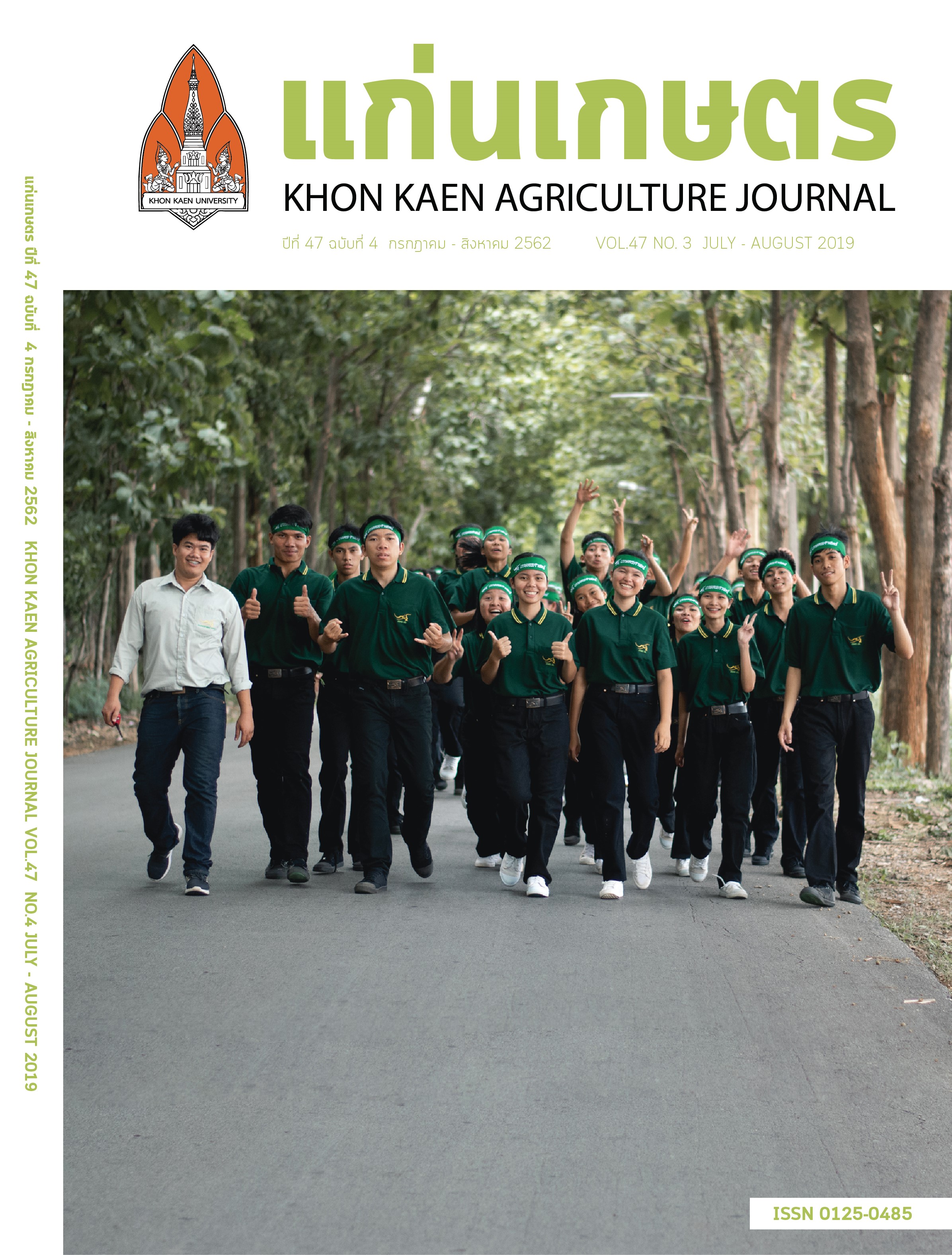ผลของสังกะสีและซิลิกอนต่อการเจริญเติบโตและผลผลิตของข้าวพันธุ์ขาวดอกมะลิ 105
Main Article Content
บทคัดย่อ
งานวิจัยนี้มีวัตถุประสงค์เพื่อศึกษาผลของสังกะสี (zinc, Zn) และซิลิกอน (silicon, Si) ต่อการเจริญเติบโตและผลผลิตของข้าวพนธุ์ขาวดอกมะลิ 105 ที่ปลูกในดินทรายร่วน (loamy sand soil) โดยทำงานทดลองในกระถางในสภาพโรงเรือน และวางแผนการทดลองแบบ randomized complete block design มี 5 กรรมวิธี และ 4 ซ้ำ ได้แก่ 1) ไม่ใส่ปุ๋ ย (T1) 2) ใส่ปุ๋ยเคมีอัตราแนะนำ (สูตร 16-16-8 และ46-0-0 อัตรา 22.5 และ 10.0 กก./ไร่ ตามลำดับ) (T2) 3) ใส่ปุ๋ยเคมีอัตราแนะนำร่วมกับ Zn อัตรา 1.1 กก./ไร่ (T3) 4) ใส่ปุ๋ยเคมีอัตราแนะนำร่วมกับ Si อัตรา 195.6 ก./ไร่ (T4) และ 5) ใส่ปุ๋ยเคมีอัตราแนะนำร่วมกับ Zn อัตรา 1.1 กก./ไร่ และ Si อัตรา 195.6 ก./ไร่ (T5) ผลการศึกษา พบว่า กรรมวิธี T2-T5 ให้องค์ประกอบของการเจริญเติบโต องค์ประกอบของผลผลิต และผลผลิตเมล็ดของข้าวสูงกว่ากรรมวิธีไม่ใส่ปุ๋ย (T1) (P<0.01) อย่างไรก็ตาม การใส่ปุ๋ยเคมีอัตราแนะนำร่วมกับ Zn และ Si (T3-T5) มีแนวโน้มทำให้องค์ประกอบของผลผลิตและผลผลิตเมล็ดสูงกว่าใส่ปุ๋ยเคมีอัตราแนะนำ (T2) (P>0.05)
Article Details
เอกสารอ้างอิง
กรมการข้าว กระทรวงเกษตรและสหกรณ์. 2553. ข้าวขาวดอกมะลิ. หนังสืออิเล็กทรอนิกส์. สำนักงานวิจัยและพัฒนาข้าว กรมการข้าว.
เบ็ญจพร กุลนิตย์. 2559. ความอุดมสมบูรณ์ของดิน: เอกสารประกอบการเรียนการสอนวิชา 0801312 ความอุดมสมบูรณ์ของดินและปุ๋ ย. ภาควิชาเทคโนโลยีการเกษตร คณะเทคโนโลยี มหาวิทยาลัยมหาสารคาม.
สำนักงานวิจัยและพัฒนาข้าว. 2560. องค์ความรู้เรื่องข้าว. แหล่งข้อมูล: http://www.brrd.in.th/rkb2/varieties/index.p-hp-file=content.php&id=65.htm. ค้นเมื่อ 13 พฤศจิกายน 2560.
สำนักงานเศรษฐกิจการเกษตร. 2561. ข้าวนาปี. แหล่งข้อมูล: http://www.oae.go.th/assets/portals/1/files/-PDF/4-60.pdf.ค้นเมื่อ 11 มกราคม 2562.
Amanullah, J., K. Inamullah, Z. Shah, and S. K. Khalil. 2016. Phosphorus and zinc interaction influence leaf area index in fi ne versus coarse rice (Oryza sativa L.) genotypes in Northwest Pakistan. Int. J. Plant Physiol. 2: 1–8.
Benton Jones, J.J. 2001. Laboratory guide for conducting soil tests and plant analysis. Boca Raton FL, CRC Press.
Cuong, T. X., H. Ullah, A. Datta, and T. C. Hanh. 2017. Effects of Silicon-Based Fertilizer on Growth, Yield and Nutrient Uptake of Rice in Tropical Zone of Vietnam. Rice Sci. 24: 283-290.
Datnoff, L.E. and F.A. Rodrigues. 2005. The Role of Silicon in Suppressing Rice Diseases. APSnet Features. doi 10.1094/APSnetFeature-2005-0205.
Dey, R., M. Biswas. M. N. Hossain Maiah, and P. Mandal. 2015. Agronomic performance of rice varieties. Int. J. Plant Soil Sci. 6: 124-139.
Esfahani, A. A., H. Pirdashti, and Y. Niknejhad. 2014. Effect of iron, zinc and silicon Application on quantitative parameters of rice (Oryza Sativa L. CV.Tarom Mahalli). Int. J. Food Allied Sci. 3: 529-533.
Foy, C.D. 1992. Soil chemical factors limiting plant root growth. Adv. Soil Sci. 19: 97-149.Ghasemi, M., H. Mobasser, A. G. Malidarreh, and H. Asadimanesh. 2013. Zinc, silicon and potassium application on rice. Int. J. Agric Crop Sci. 5: 936-942.
Jing, Q., T. Dai, D. Jiang, Y. Zhu, and W. Cao. 2007. Spatial distribution of leaf area index and leaf N content in relation to grain yield and nitrogen uptake in rice. Plant Prod. Sci. 10: 136 -145.
Khan, R., A.R. Gurmani, M.S. Khan, and A.H. Gurmani. 2007. Effect of zinc application on rice yield under wheat rice system. Pak. J. Biol. Sci. 10: 235-239.
Korndörfer, G.H. Snyder, M. Ulloa, G. Powell, and L.E. Datnoff. 2006. Calibration of soil and plant silicon analysis for rice production. J. Plant Nutr. 24:1071-1084.
Marschner, H. 1995. Mineral nutrition of higher plants. 2nd Edition, Academic Press, London.Massey, F.P. and S.E. Hartley. 2006. Experimental demonstration of the antiherbivore effects of silica in grasses: Impacts on foliage digestibility and vole growth rates. In: Proc. Royal Soc. B. 273: 2299-2304.
Mehrabanjoubani, P., A. Abdolzadeh, H.R. Sadeghipour, and M. Aghdasi. 2015. Impacts of silicon nutrition on growth and nutrient status of rice plants grown under varying zinc regimes. Theor. Exp. Plant Phys. 27: 19-29.
Mustafa, G., E. Ullah, N. Akbar, S.A. Qaisrani, A. Iqbal, H.Z. Khan,K Jabran, A.A. Chattha, R. Trethowan, T. Chattha, and B.M. Atta. 2011. Effect of zinc application on growth and yield of rice (Oryza sativa L.). IJAVMS. 5: 530-535.
Sarma, R.S., D. Shankhdhar, S.C. Shankhdhar, and P. Srivastava. 2017. Effect of silicon solublizers on growth parameters and yields attributes in different rice genotypes. Int. J. Pure App. Biosci. 5: 60-67.
Sinclair T.R. and R.C. Muchow. 1995. Effect of nitrogen supply of maize yield: I. Modeling physiological responses. Agron. J. 87: 632-641.
Song, A., P. Li, F. Fan, Z. Li, and Y. Liang. 2014. The Effect of silicon on photosynthesis and expression of its relevant genes in rice (Oryza sativa L.) under high-zinc stress. Plos One 26: 1-21. DOI:10.1371-/journal.pone.0113782.
Sun, Y., C. Tong, S. He, K. Wang, and L. Chen. 2018. Identification of nitrogen, phosphorus, and potassium deficiencies based on temporal dynamics of leaf morphology and color. Sustainability. 10: 1-14.
Vollmann, J., H. Walter, T. Sato, and P. Schweiger. 2011. Digital image analysis and chlorophyll metering for phenotyping the effects of nodulation in soybean. Comput. Electron. Agr. 75: 190-195.
Wissuwa, M., A.M. Ismail, and S. Yanagihara. 2006. Effects of zinc deficiency on rice growth and genetic factors contributing to tolerance. Plant Physiol. 142: 731-741.
Yuan, Z., Q. Cao, K. Zhang, S. T. Ata-Ul-Karim, Y. Tian, Y. Zhu, W. Cao, and X. Liu. 2016. Optimal leaf positions for SPAD meter measurement in rice. Front. Plant Sci. 7: 1-10.
Zakeri, H., J. Schoenau, A. Vandenberg, M.T. Aligodarz, and R.A. Bueckert. 2015. Indirect estimations of lentil leaf and plant N by SPAD chlorophyll meter. Int. J. Agron. 1-10. DOI: 10.1155/2015/748074.


